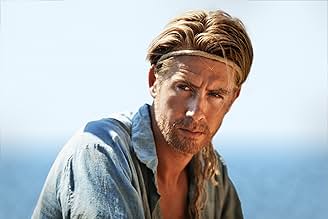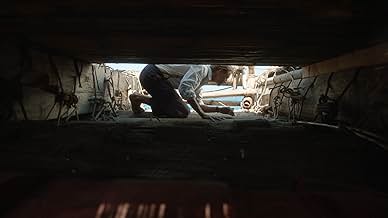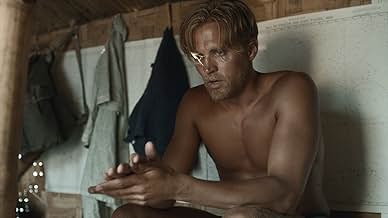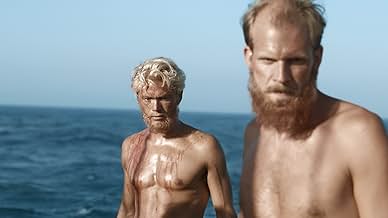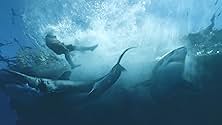Película basada en la historia real del explorador Thor Heyerdahl, que en 1947 cruzó el Atlántico en una balsa de madera. En 1950 el propio Thor Heyerdahl dirigio un documental sobre su haza... Leer todoPelícula basada en la historia real del explorador Thor Heyerdahl, que en 1947 cruzó el Atlántico en una balsa de madera. En 1950 el propio Thor Heyerdahl dirigio un documental sobre su hazaña, ganador al Oscar al mejor documental.Película basada en la historia real del explorador Thor Heyerdahl, que en 1947 cruzó el Atlántico en una balsa de madera. En 1950 el propio Thor Heyerdahl dirigio un documental sobre su hazaña, ganador al Oscar al mejor documental.
- Dirección
- Guionista
- Elenco
- Nominado a 1 premio Óscar
- 12 premios ganados y 14 nominaciones en total
- Thor Heyerdahl
- (as Pål Hagen)
- Herman Watzinger
- (as Anders Baasmo Christiansen)
- Thor 6 yrs.
- (as Kasper Ameberg Johnsen)
- Dirección
- Guionista
- Todo el elenco y el equipo
- Producción, taquilla y más en IMDbPro
Opiniones destacadas
If nothing else, Kon-Tiki (the name of the aforementioned vessel) adds to the impressive list of superb films from Scandinavia this past year. From Headhunters (one of my favourites of 2012) to the overlooked Snabba cash (Easy Money), fare from this region has never been more accessible or memorable.
So now comes Kon-Tiki, the first Norwegian film to score both a nomination at the Golden Globe and Academy Award ceremonies, and it's rather easy to see why. This sweeping journey appeals squarely to Hollywood sensibilities, twisting up an epic, historical adventure about overcoming the odds, with human drama. Though this intentional slanting may take some of the complexity and grit out of the film in the end, praise is abundantly deserved for all those involved.
Chief on that list is filmmaking duo Joachim Rønning and Espen Sandberg, best known previously for the Luc Besson-produced Bandidas with Penelope Cruz and Selma Hayek, who craft something lavish and visually sumptuous out of this trek, despite the hurdle of being endowed with a budget of just $16 million.
By recreating Heyerdahl's raft, shooting out over the deep and using special effects only as infrequent enhancements rather than a crutch, these two lay the authenticity on thick and in doing so generate tension and wonder (sometimes simultaneously) like you wouldn't imagine. Kon- Tiki, though never overtly stealing, mirrors the most effective aspects of films like Cast Away, Jaws and Mutiny on the Bounty.
When Rønning and Sandberg aren't capturing sweeping, stunning shots of the Pacific (and the tiny boat at its mercy) they are letting the camera rest on the diminutive aspects of the voyage, at least so when compared to the grandness of what's around them. The ropes lashing together the massive balsa wood beams strain and groan in the water, summoning us back to an earlier scene where two sailors warn Heyerdahl that a raft of that nature will inevitably break apart with the movement of the logs. Sharks silently circle and the boat slowly crumbles as the wood absorbs seawater. These quiet moments are as unnerving as anything you'll see on the big screen.
Likewise, there are grander, more elaborate moments that drip with tension all the same, as when storms hit, men are cast overboard, and once again sharks, though proving to be one of the lesser threats in the scheme of things, use their mythos alone to chill to the bone. If not as complex as it could have been, Kon-Tiki is certainly never dull.
The cast of unknown actors are also strong, even if by the time the credits role their sporting of Grizzly Adams-like beards makes identifying between some of these brave men difficult. Leading the way as the driven Heyerdahl is – wait for this one – Pål Sverre Valheim Hagen, anchoring (no pun intended) the film as a man intent on proving his settlement theory to sceptical scholars. Joining him is engineer (and refrigerator salesman) Herman Watzinger (Anders Baasmo Christiansen) navigator Erik Hesselberg (Odd Magnus Williamson) ethnographer Bengt Danielsson (Gustaf Skarsgård) and two soldiers acting as radio men Knut Haugland and Torstein Raaby (Tobias Santelmann and Jakob Oftebro respectively).
Together, crammed together like sardines, they make the 101-day journey, each bringing not only their respective skill-sets but demons as well. Those versed in Heyerdahl's novel or the documentary of the voyage (the winner of the 1950 Oscar for Best Documentary Feature) may cry afoul at some of the changes that have been made in service to crafting a more dramatic effort, particularly tweaks to the Watzinger character, but they will in no way impact how most will respond to Kon-Tiki.
Though not as weighty or viscerally lasting as some fare that pops up in the Best Foreign Language Film category, it is, however, infinitely accessible to anyone who usually turns their nose up at that particular segment of the ceremony. Kon-Tiki is a strong import, fascinating and thrilling in equal measure and a film that is just as much about the perils of nature as it is about the gratification that comes with conquering it.
Anyway, even though I have not watched nor have any knowledge of the original, I am impressed with the way this film was made. It was pretty well-balanced with no major flaws in my opinion. Well acting performances by the cast were complemented by a high level of cinematography technique that made looked like the entire journey on the raft was really shot wide in the ocean. Like Life of Pi, there were certain marine animals that were infamously being shown from the real life account of Kon-Tiki, and the CGI made on the animals were so real you probably cant tell if those animals were fake.
Probably the major point of improvement that the film can work on is the lack of character development of the other participants in the Kon Tiki, aside from Thor Heyerdahl himself. I am not implying there was none, as we get to see Thor's mates conflicts happening from the start till the end, but I wish I could have known more why they decided to join and their background story. Understandably, with the time given the film had chosen to focus on Thor instead with a lot of plot material explaining why he had to venture into such a journey.
I was also curious if there were more that could be shown about a group of men enduring a raft journey across the ocean in +100 days. But overall, just by solely comparing the similarities, this is much better and believable than Life of Pi as well as a very satisfying movie experience.
During the 20th century some individual achievements so captured the popular attention as to become iconic: Lindberg's flight across the Atlantic, Hillary and Norgay's conquest of Everest, Roger Bannister's four minute mile. Thor Heyerdahl's 1947 voyage across the Pacific was one of these events. His book, Kon-Tiki, sold tens of millions of copies, and his 1950 documentary won an Academy Award, as much a recognition of the feat as the film.
Norwegian directors Joachim Rønning and Espen Sandberg have now decided to put on the screen a dramatized account of Heyerdahl's expedition. But the obvious question is how can you make interesting the story of six men confined to a small wooden raft for 101 days? In fact by comparison to the exploit it recorded, the original documentary came across as rather bland, precisely because of such limitations. But this new film is anything but tame, and succeeds in combining striking photography of the adventure itself with a compelling look at one man's quest to show that "it can be done."
The strength of the picture is that it situates the voyage within the context of Heyerdahl's struggle to get the scientific and financial support to try out his theories. He had speculated that Polynesia was settled by Inca voyagers who had used the prevailing currents to drift across the Pacific on rafts similar to the one he would build. (He proved this possible, although DNA testing suggests that Polynesians share a predominantly Asian heritage.)
Heyerdahl had developed this premise much earlier, but after World War II, he made serious attempts to secure the backing for a voyage that would test his theories. Not only did he encounter opposition from those who felt that he was wrong, but even more often he was dismissed as a fanatic with a suicidal plan.
Eventually he did manage to scrounge some backing, including private loans, help from the Peruvian authorities and supplies from the U.S. Navy. Perhaps more importantly, he found five companions who had confidence enough to put their lives in his hands. All were Norwegian except Bengt Danielsson, a Swede with an interest in migration. Erik Hesselberg was the navigator. Knut Haugland and Torstein Raaby, both heroes of the Norwegian resistance, were the radio experts. Herman Watzinger was an engineer who helped design the raft, and who recorded much of the voyage's scientific data.
Although he took along modern equipment, Heyerdahl was concerned that the raft itself should be constructed only from materials that were available in ancient times. Accordingly the raft was constructed from logs tied together with rope, surmounted by a thatched cabin and a large cloth sail. The raft itself was about 45 by 18 feet (13.7 by 5.5 m), and the cabin about 14 by 8 (4.2 by 2.4 m). The crew sailed from Callao, Peru, on April 28, 1947 and arrived in Raroia in the Tuamotu Islands on August 7.
The film succeeds by contextualizing these 101 days at sea against Heyerdahl's struggles to get the expedition underway. Although the inevitable storm and the equally foreseeable shark attack have their moments, the movie similarly attends to the relationships among the expedition's six members, their level of bonding to Heyerdahl as leader, and his own relationship with a wife who wanted to be supportive, but who found the risks unacceptable. It establishes the overall context by its early sequence dealing with Thor's honeymoon stay in the Marquesas, where he began to discover the apparent Inca connections that led to his theories.
In the central role of Thor Heyerdahl, Pål Sverre Valheim Hagen must carry the story, and he does. His re-creation of the historical character is convincing as the embodiment of determination, not quite obsessive but coming close, as he plans, argues and cajoles to try to turn his project into a reality. As his fellow Norwegian crew members Odd Magnus Williamson as Hesselberg, Tobias Santlemann as Haugland, and Jacob Oftebro as Raaby are equally credible figures: young, heroic, and willing to give Heyerdahl their trust. Playing the only non-Norwegian in the group, Gustaf Skarsgård as Bengt Danielsson is a little detached, but perhaps even more intellectually committed than the others to what they are about. For contrast and drama, the filmmakers apparently took liberties with the character of Herman Watzinger, played by Anders Baasmo Christensen. Christensen does well with the part given him, although the real-life Watzinger was almost certainly stronger and more competent than the movie shows him. Given that she must play an ambivalent role, Agnes Kittelsen as Liv gives a very effective performance as Thor's wife and the film's only prominent female character.
Gorgeous photography and great production values set Kon-Tiki off. The Pacific Ocean scenes were actually shot in the waters off Malta, the tropical ones in the Maldives and Thailand, with other locations in Norway and the U.S. used as appropriate. It is a real accomplishment that even with the limited space of the raft cinematographer Geir Hartly Andreassen never lets it become visually boring. Going from the micro to the macro, he manages to keep interesting also the vast empty spaces of the ocean, which emerges as a living character in its own right, often peaceful, sometimes petrifying, always powerful.
It must have been a temptation for the directors and principal screenwriter Petter Skavlan to fictionalize Heyerdahl's exploits and to create a stunning action/adventure tale on the lines of A Perfect Storm or White Squall. Thankfully they recognized that Heyerdahl himself was a character larger than life whose daring voyage became an extension of himself and his ambitions. In doing that they keep alive the iconic figure that he was, and give audiences some appreciation of how the sheer willpower of one individual can produce deeds that capture the imagination of the world.
I'm not saying this just because I'm Norwegian and extremely proud that my country managed to produce this amazing adventure. Kon-Tiki is definitely one of the most original, well- written and fun films I've seen this year.
It's the 1940s. Without spoiling the story (which is real by the way), we are invited to follow Thor Heyerdahl as he gathers a crew of overly confident Scandinavians attempting to cross the Pacific on a balsa wood raft. All in the name of science and a boyish thirst for adventure! This attitude is understandable; after enduring the misery of WW2, little seemed more tempting than escaping to faraway exotic lands. Bravery or stupidity? In either case, viewers can look forward to one hell of a boat ride.
What I adore about Kon-Tiki is the presentation of the raft's surroundings. The Pacific Ocean is just as magnificent and beautiful as it is dangerous and merciless, and this dynamic is perfectly balanced. Peaceful waters and clear skies suddenly give way for dangerous sea- creatures and storms mighty enough to tear the old-fashioned raft apart. Kon-Tiki is simply grand. At times my adrenaline rose, my heart started pumping, and I started lusting for adventure myself - just by watching.
Another strong point is the cast. The actors do a brilliant job at depicting the slightly eccentric yet adventurous Scandinavians far away from their Nordic comfort zone. Thor Heyerdahl is particularly well portrayed with his dreamer-like attitude and awkward English skills. Although I would prefer more emphasis on character development, Kon-Tiki make them just interesting enough for viewers to care for them.
Kon-Tiki is such a delight to watch, because it's original, different and not your typical Hollywood adventure flick. No, the plot is not complex. It has no twists or turns, and Kon-Tiki certainly doesn't contain the amount of drama you'd expect. And this is what makes it good - the film is all about the sheer excitement of the adventure. Of course it isn't perfect, but for a Norwegian film, I'd say it holds its ground rather strongly.
I honestly haven't had this much fun with a film for a long while. If you're lucky, Kon-Tiki might show up on a festival or international cinema near you. In that case, do watch it.
The film began with Thor as a child when he fell into the icy lake and almost drowned. However we later find out that that accident and his inability to swim did not deter his adventurous spirit. We fast forward to Thor and his wife Liv on Fatu Hiva, a Polynesian island, in 1937. There he learned the belief of the islanders that their ancestor Tiki actually came from the East (the Americas) instead of Asia as commonly assumed.
For several years, Thor tried to get his theory about Polynesian origins published but was repeatedly rejected. Therefore, he resolved to prove his theory by recreating Tiki's original ocean journey from Peru to Polynesia on a raft made of balsa wood (with strictly no modern materials).
It is just too coincidental that I am watching another ocean adventure just a few days after watching "Life of Pi." Kon-Tiki traveled the Pacific in the opposite direction that Pi did. It had an experienced though spare crew of 5, composed of two sailors, an engineer, an ethnographer and Thor, so it had a distinct advantage over the teenager and a tiger.
But maybe because I just watched Pi, maybe I expected to see so much more maritime misfortune than I did with Kon-Tiki. However, that sequence with vicious sharks had real heart-stopping suspense. I do have some misgivings about that episode with the whale shark, because it is not really the aggressive creature depicted in the film.
This was a straight-forward adventure film for the family. It may seem old-fashioned to some, nothing too controversial or strange as one can expect from modern European cinema. It was by no means boring, but I admit I felt like it lacked a certain edge while I was watching it. The crew members did not even have any significant conflict among each other and they were trapped on a raft for a hundred days! That may come across as unbelievable in these days of Big Brother and other "reality" TV shows.
I do hope I can find myself a copy of the 1950 Oscar-winning documentary about the real Thor Heyerdahl, his crew and their 101-day oceanic ordeal. That should be very interesting indeed.
¿Sabías que…?
- TriviaLarge parts of the film were filmed in two versions at the same time, one in Norwegian, the other in English, in order to secure international funding. See ALTERNATE VERSIONS section for greater detail.
- ErroresThe crew were not worried about whether the ropes would hold the float together, as it is portrayed in the film. As we can see in the Kon-Tiki (1950) documentary, the balsa wood was much softer than the rope, and it was actually the rope that ate through the wood. The result was that the rope eventually was protected by the space that had been created around it.
- Citas
Epilogue: Bengt fell in love with Polynesia. He settled there and became a Consul General of Sweden. He died in 1997.
Epilogue: Erik built himself a sailboat, that became his home for 11 years. He worked as an artist until his death in 1972.
Epilogue: Torstein kept going on expeditions. He died in 1964 during an attempt to reach the North Pole on skis.
Epilogue: Knut resumed his career in military intelligence. He was also instrumental in the establishment of the Kon-Tiki museum. He died the Christmas of 2009.
Epilogue: Herman became the director of UN's Food and Agriculture organization. He died at Titica lake in 1986.
Epilogue: Thor wrote a book about Kon-Tiki. It was translated to over 70 languages, and sold over 50 million copies. The documentary about the expedition won an Oscar. Liv and Thor divorced after the Kon-Tiki expedition. Their boys lived with Liv, who later moved to the US where she died in 1969. Thor continued his work as an experimental archaeologist, author and explorer. He died in 2002.
- Créditos curiososBefore the closing credits, short clips are shown in which original footage shot by Heyerdahl was reenacted by the "Kon-Tiki" actors: urinating overboard in the open sea, dancing with natives under palms, portraits, and the like. Along with this, brief notes concerning each crew member's path of life after the trip are given.
- Versiones alternativasIn an unusual technique, the film was shot simultaneously in both Norwegian and English, with each scene being filmed twice, first in Norwegian and then in English, with the same actors. This resulted in two versions of the film to be released, one primarily for the Norwegian domestic market, the other for an international audience. In a few cases, such as action scenes and computer-generated sequences, they used the same shot, later adding English with dubbing.
- ConexionesFeatured in 70th Golden Globe Awards (2013)
- Bandas sonorasFlickan i Havanna
("The girl in Havana")
Lyrics by Evert Taube (as Taube) and music by Horatio R. Palmer (as Palmer)
Selecciones populares
Detalles
- Fecha de lanzamiento
- Países de origen
- Sitios oficiales
- Idiomas
- También se conoce como
- Kon-Tiki
- Locaciones de filmación
- Nu Boyana Film Studios, Sofía, Bulgaria(New York exterior scenes)
- Productoras
- Ver más créditos de la compañía en IMDbPro
Taquilla
- Presupuesto
- USD 16,600,000 (estimado)
- Total en EE. UU. y Canadá
- USD 1,517,410
- Fin de semana de estreno en EE. UU. y Canadá
- USD 22,168
- 28 abr 2013
- Total a nivel mundial
- USD 22,842,887
- Tiempo de ejecución1 hora 58 minutos
- Color
- Mezcla de sonido
- Relación de aspecto
- 2.35 : 1
Contribuir a esta página






